Migration and Alignment of Three Interacting Particles in Poiseuille Flow of Giesekus Fluids
Abstract
:1. Introduction
2. Numerical Model
2.1. Fictitious Domain Method
2.2. Collision Model
2.3. Simulation Setup
3. Results and Discussion
3.1. Effect of Initial Distance from the Centerline on the Interparticle Distance
3.2. Effect of Weissenberg Number on the Interparticle Distance
3.3. Effect of Shear-Thinning on the Interparticle Distance
3.4. Effect of Wall Confinement on the Interparticle Distance
3.5. Abnormal Cross-Flow Migration of Particles
4. Conclusions
Author Contributions
Funding
Institutional Review Board Statement
Informed Consent Statement
Data Availability Statement
Conflicts of Interest
References
- Pratt, E.D.; Huang, C.; Hawkins, B.G.; Gleghorn, J.P.; Kirby, B.J. Rare cell capture in microfluidic devices. Chem. Eng. Sci. 2011, 66, 1508–1522. [Google Scholar] [CrossRef] [Green Version]
- Pedrol, E.; Massons, J.; Diaz, F.; Aguilo, M. Study of local inertial focusing conditions for spherical particles in asymmetric serpentines. Fluids 2020, 5, 1. [Google Scholar] [CrossRef] [Green Version]
- Masaeli, M.; Sollier, E.; Amini, H.; Mao, W.; Camacho, K.; Doshi, N.; Mitragotri, S.; Alexeev, A.; Di Carlo, D. Continuous inertial focusing and separation of particles by shape. Phys. Rev. X 2012, 2, 031017. [Google Scholar] [CrossRef] [Green Version]
- Ateya, D.A.; Erickson, J.S.; Howell, P.B., Jr.; Hilliard, L.R.; Golden, J.P.; Ligler, F.S. The good, the bad, and the tiny: A review of microflow cytometry. Anal. Bioanal. Chem. 2008, 391, 1485–1498. [Google Scholar] [CrossRef] [Green Version]
- Godin, J.; Chen, C.; Cho, S.H.; Qiao, W.; Tsai, F.; Lo, Y. Microfluidics and photonics for bio-system-on-a-chip: A review of advancements in technology towards a microfluidic flow cytometry chip. J. Biophotonics 2008, 1, 355–376. [Google Scholar] [CrossRef] [PubMed] [Green Version]
- Kersaudy-Kerhoas, M.; Dhariwal, R.; Desmulliez, M.P.Y. Recent advances in microparticle continuous separation. IET Nanobiotechnol. 2008, 2, 1–13. [Google Scholar] [CrossRef]
- Kulrattanarak, T.; van der Sman, R.G.M.; Schroen, C.G.P.H.; Boom, R.M. Classification and evaluation of microfluidic devices for continuous suspension fractionation. Adv. Colloid Interface Sci. 2008, 142, 53–65. [Google Scholar] [CrossRef]
- Kummrow, A.; Theisen, J.; Frankowski, M.; Tuchscheerer, A.; Yildirim, H.; Brattke, K.; Schmidt, M.; Neukammer, J. Microfluidic structures for flow cytometric analysis of hydrodynamically focussed blood cells fabricated by ultraprecision micromachining. Lab Chip 2009, 9, 972–981. [Google Scholar] [CrossRef]
- Segré, G.; Silberberg, A. Radical particle displacements in Poiseuille flow of suspensions. Nature 1961, 189, 209–210. [Google Scholar] [CrossRef]
- Karnis, A.; Mason, S.G. Particle motions in sheared suspensions. xix. viscoelastic media. Trans. Soc. Rheol. 1966, 10, 571–592. [Google Scholar] [CrossRef]
- Villone, M.M.; D’Avino, G.; Hulsen, M.A.; Greco, F.; Maffettone, P.L. Numerical simulations of particle migration in a viscoelastic fluid subjected to Poiseuille flow. Comput. Fluids 2011, 42, 82–91. [Google Scholar] [CrossRef]
- Villone, M.M.; D’Avino, G.; Hulsen, M.A.; Greco, F.; Maffettone, P.L. Particle motion in square channel flow of a viscoelastic liquid: Migration vs.secondary flows. J. Non-Newton. Fluid Mech. 2013, 195, 1–8. [Google Scholar] [CrossRef]
- Spanjaards, M.M.A.; Jameson, N.O.; Hulsen, M.A.; Anderson, P.D. A Numerical Study of particle migration and sedimentation in viscoelastic Couette flow. Fluids 2019, 5, 25. [Google Scholar] [CrossRef] [Green Version]
- Huang, P.Y.; Feng, J.; Hu, H.H.; Joseph, D.D. Direct simulation of the motion of solid particles in Couette and Poiseuille flows of viscoelastic fluids. J. Fluid Mech. 1997, 343, 73–94. [Google Scholar] [CrossRef] [Green Version]
- Wang, P.; Yu, Z.; Lin, J.Z. Numerical simulations of particle migration in rectangular channel flow of Giesekus viscoelastic fluids. J. Non-Newton. Fluid Mech. 2018, 262, 142–148. [Google Scholar] [CrossRef]
- Yu, Z.; Wang, P.; Lin, J.Z.; Hu, H. Equilibrium positions of the elasto-inertial particle migration in rectangular channel flow of Oldroyd-B viscoelastic fluids. J. Fluid Mech. 2019, 868, 316–340. [Google Scholar] [CrossRef]
- Snijkers, F.; Pasquino, R.; Vermant, J. Hydrodynamic interactions between two equally sized spheres in viscoelastic fluids in shear flow. Langmuir 2013, 29, 5701–5713. [Google Scholar] [CrossRef]
- Michele, J.; Patzold, R.; Donis, R. Alignment and aggregation effects in suspensions of spheres in non-Newtonian media. Rheol. Acta 1977, 16, 317–321. [Google Scholar] [CrossRef]
- Choi, Y.J.; Hulsen, M.A. Alignment of particles in a confined shear flow of aviscoelastic fluid. J. Non-Newton. Fluid Mech. 2012, 175–176, 89–103. [Google Scholar] [CrossRef]
- Xiang, N.; Dai, Q.; Ni, Z.H. Multi-train elasto-inertial particle focusing in straight microfluidic channels. Appl. Phys. Lett. 2016, 109, 134101. [Google Scholar] [CrossRef]
- Pasquino, R.; Snijkers, F.; Grizzuti, N.; Vermant, J. The effect of particle size and migration on the formation of flow-induced structures in viscoelastic suspensions. Rheol. Acta 2010, 49, 993–1001. [Google Scholar] [CrossRef]
- Pan, A.; Zhang, R.; Yuan, C.; Wu, H.Y. Direct measurement of microscale flow structures induced by inertial focusing of single particle and particle trains in a confined microchannel. Phys. Fluids 2018, 30, 102005. [Google Scholar] [CrossRef]
- D’Avino, G.; Hulsen, M.A.; Maffettone, P.L. Dynamics of pairs and triplets of particles in a viscoelastic fluid flowing in a cylindrical channel. Comput. Fluids 2013, 86, 45–55. [Google Scholar] [CrossRef]
- Glowinski, R.; Pan, T.-W.; Hesla, T.I.; Joseph, D.D. A distributed Lagrange multiplier/fictitious domain method for particulate flows. Int. J. Multiph. Flow 1999, 25, 755–794. [Google Scholar] [CrossRef]
- Yu, Z.; Shao, X. A direct-forcing fictitious domain method for particulate flows. J. Comput. Phys. 2007, 227, 292–314. [Google Scholar] [CrossRef]
- Yu, Z.; Wachs, A. A fictitious domain method for dynamic simulation of particle sedimentation in Bingham fluids. J. Non-Newton. Fluid Mech. 2007, 145, 78–91. [Google Scholar] [CrossRef]
- Yu, Z.; Xia, Y.; Guo, Y.; Lin, J.Z. Modulation of turbulence intensity by heavy finite-size particles in upward channel flow. J. Fluid Mech. 2021, 913, 1140. [Google Scholar] [CrossRef]
- Hu, H.H.; Patankar, N.A.; Zhu, M.Y. Direct numerical simulations of fluid-solid systems using the arbitrary Lagrangian–Eulerian technique. J. Comput. Phys. 2001, 169, 427–462. [Google Scholar] [CrossRef]
- Joseph, D.D.; Liu, Y.J.; Poletto, M.; Feng, J. Aggregation and dispersion of spheres falling in viscoelastic liquids. J. Non-Newton. Fluid Mech. 1994, 54, 45–86. [Google Scholar] [CrossRef]
- Daugan, S.; Talini, L.; Herzhaft, B.; Allain, C. Aggregation of particles settling in shear-thinning fluids. Part 1. Two-particle aggregation. Eur. Phys. J. E 2002, 7, 73–81. [Google Scholar] [CrossRef]
- Yu, Z.; Wachs, A.; Peysson, Y. Numerical simulation of particle sedimentation in shear-thinning fluids with a fictitious domain method. J. Non-Newton. Fluid Mech. 2006, 136, 126–139. [Google Scholar] [CrossRef]
- Dhahir, S.A.; Walters, K. On non-Newtonian flow past a cylinder in a confined flow. J. Rheol. 1989, 33, 781–804. [Google Scholar] [CrossRef]
- Sullivan, M.T.; Moore, K.; Stone, H.A. Transverse instability of bubbles in viscoelastic channel flows. Phys. Rev. Lett. 2008, 101, 244503. [Google Scholar] [CrossRef] [Green Version]
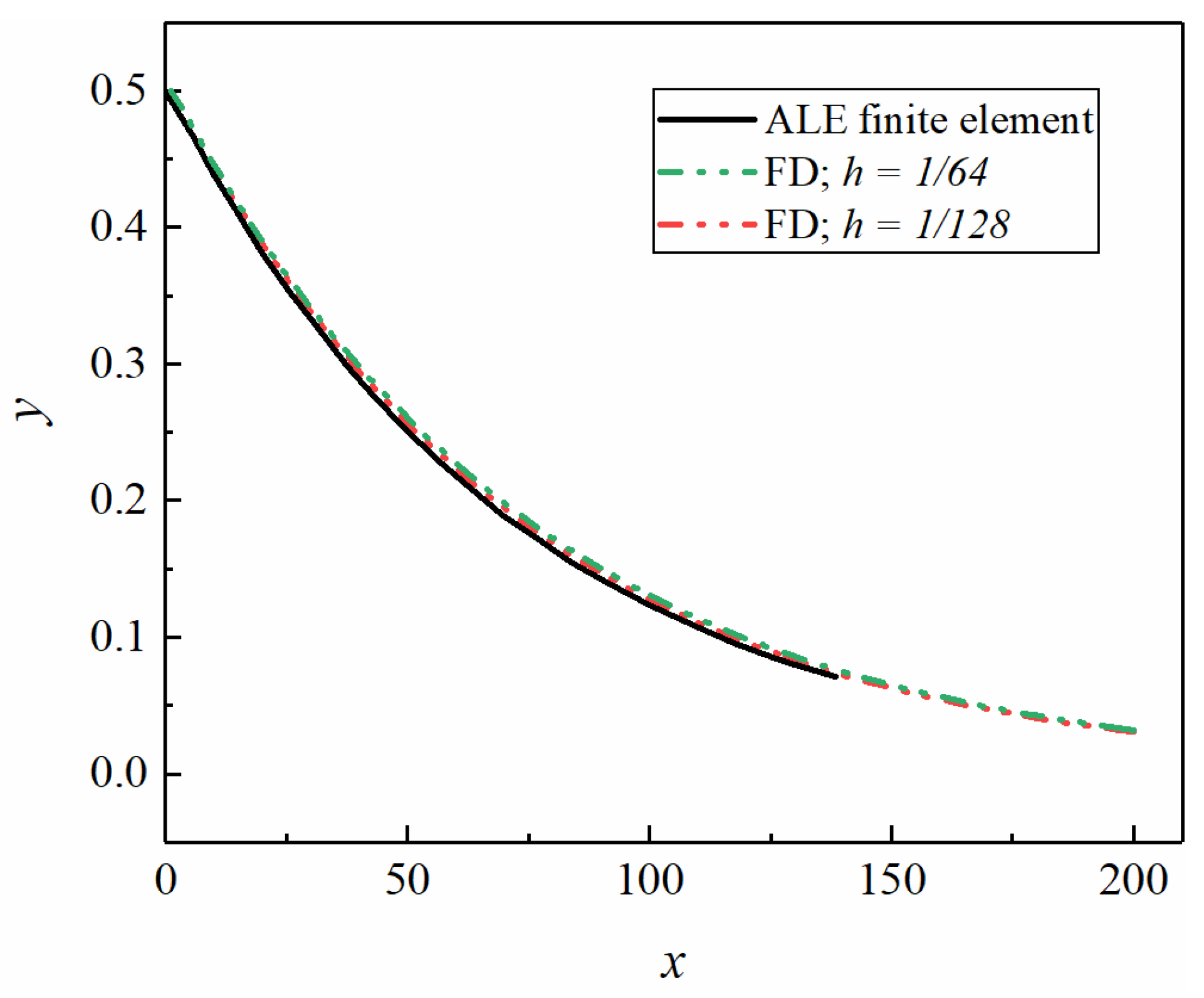

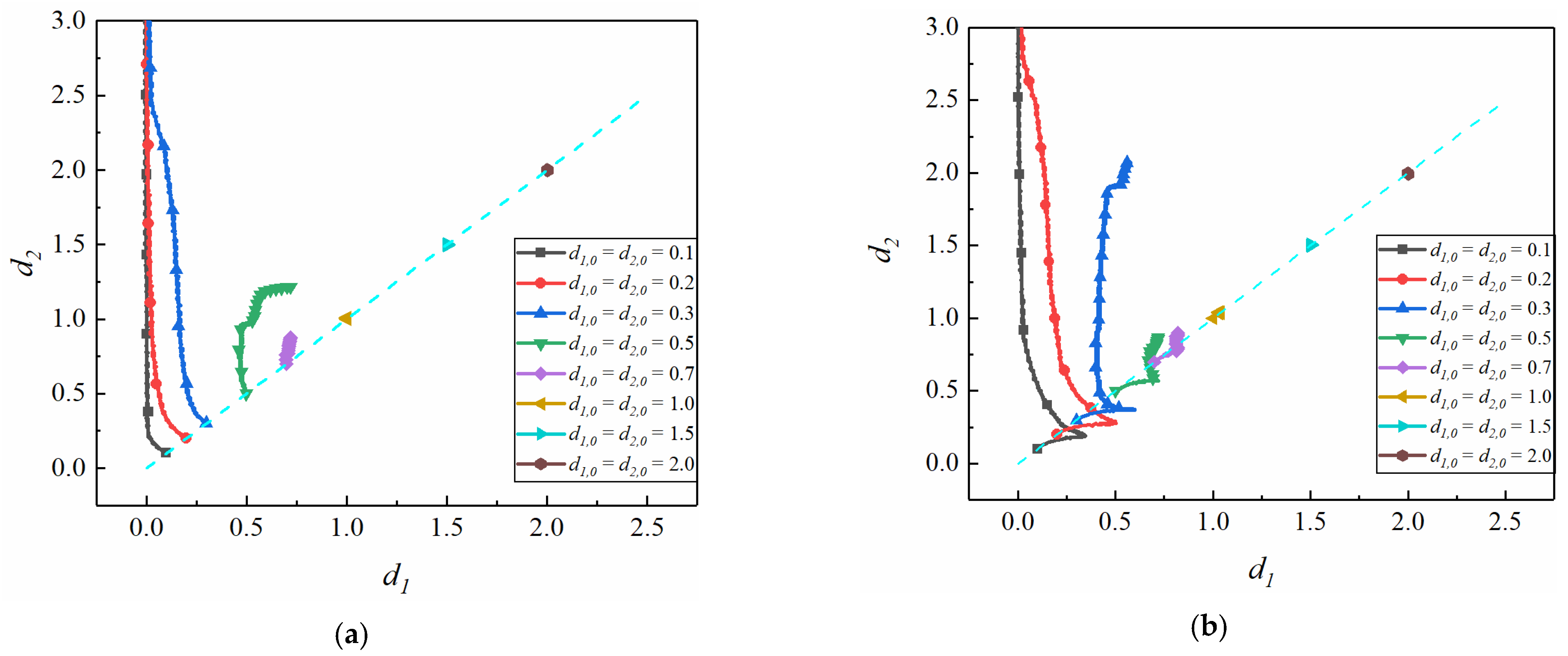
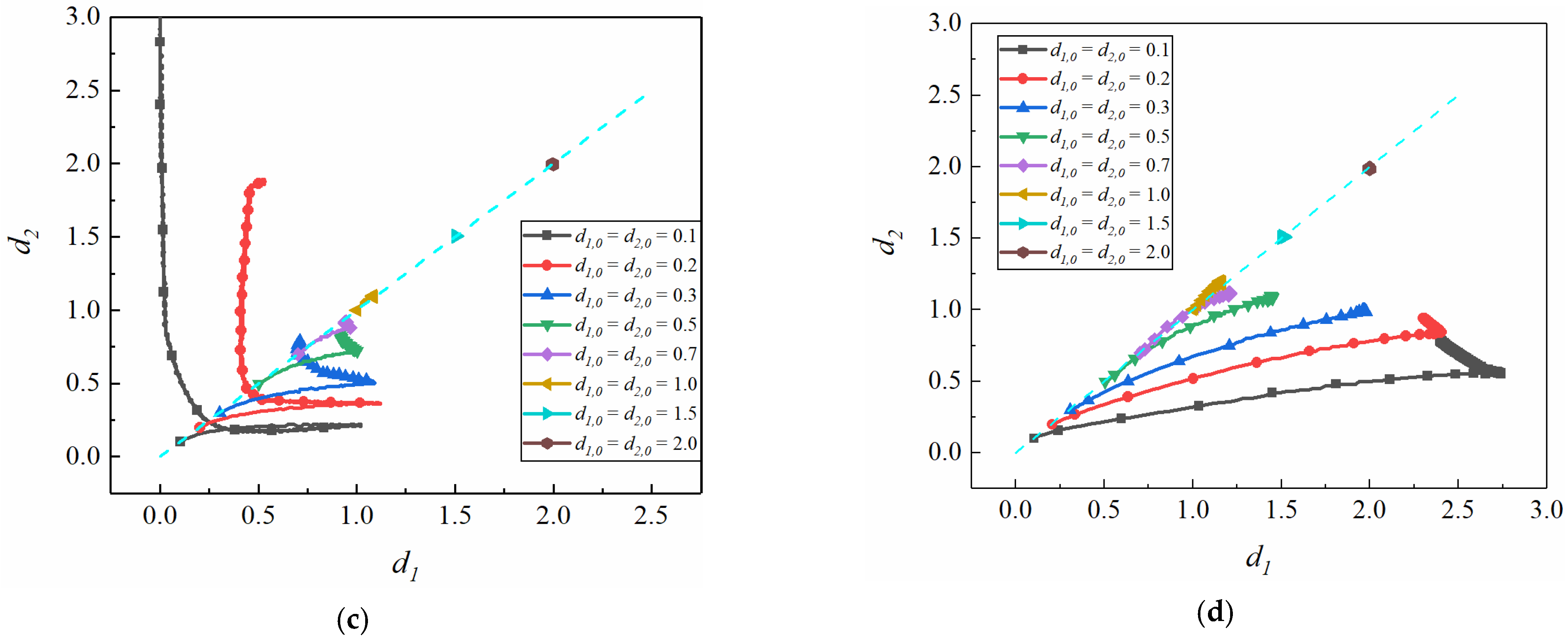
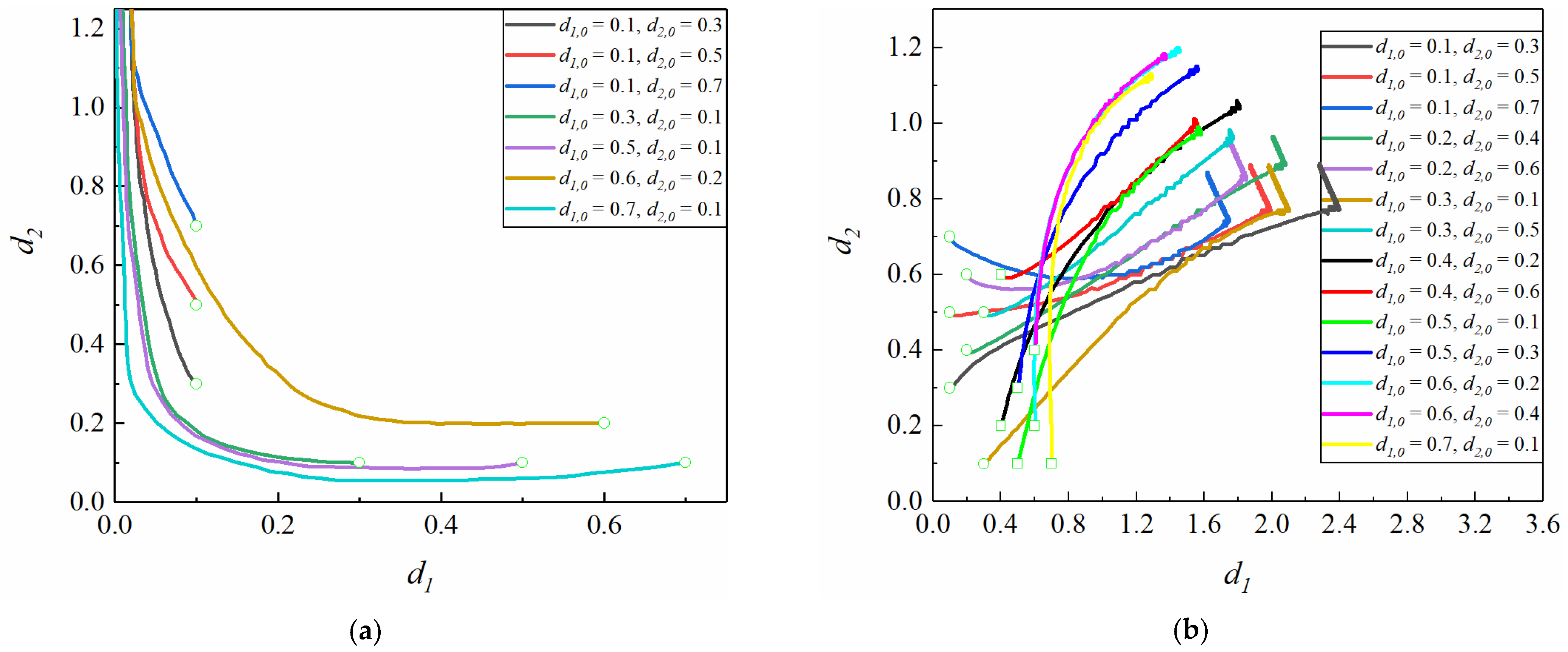
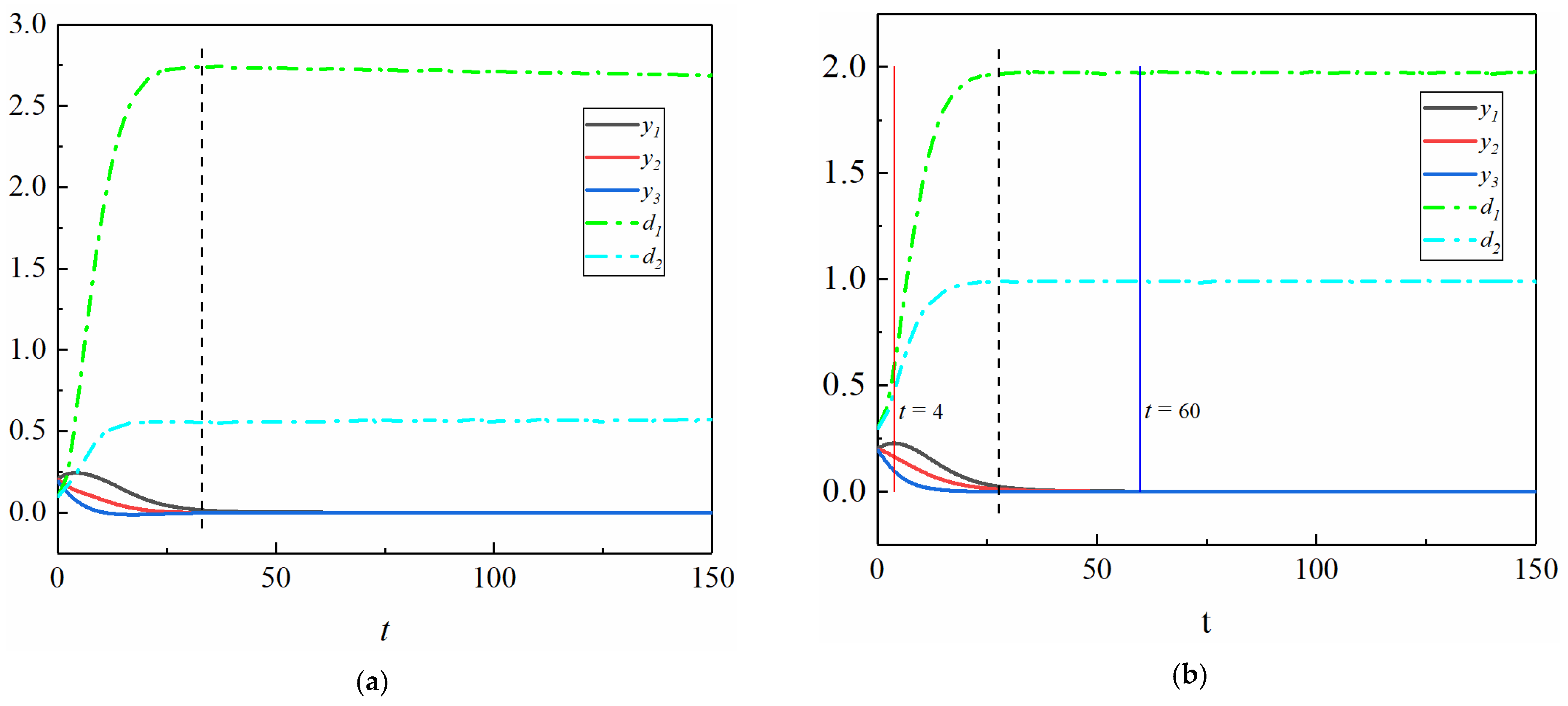
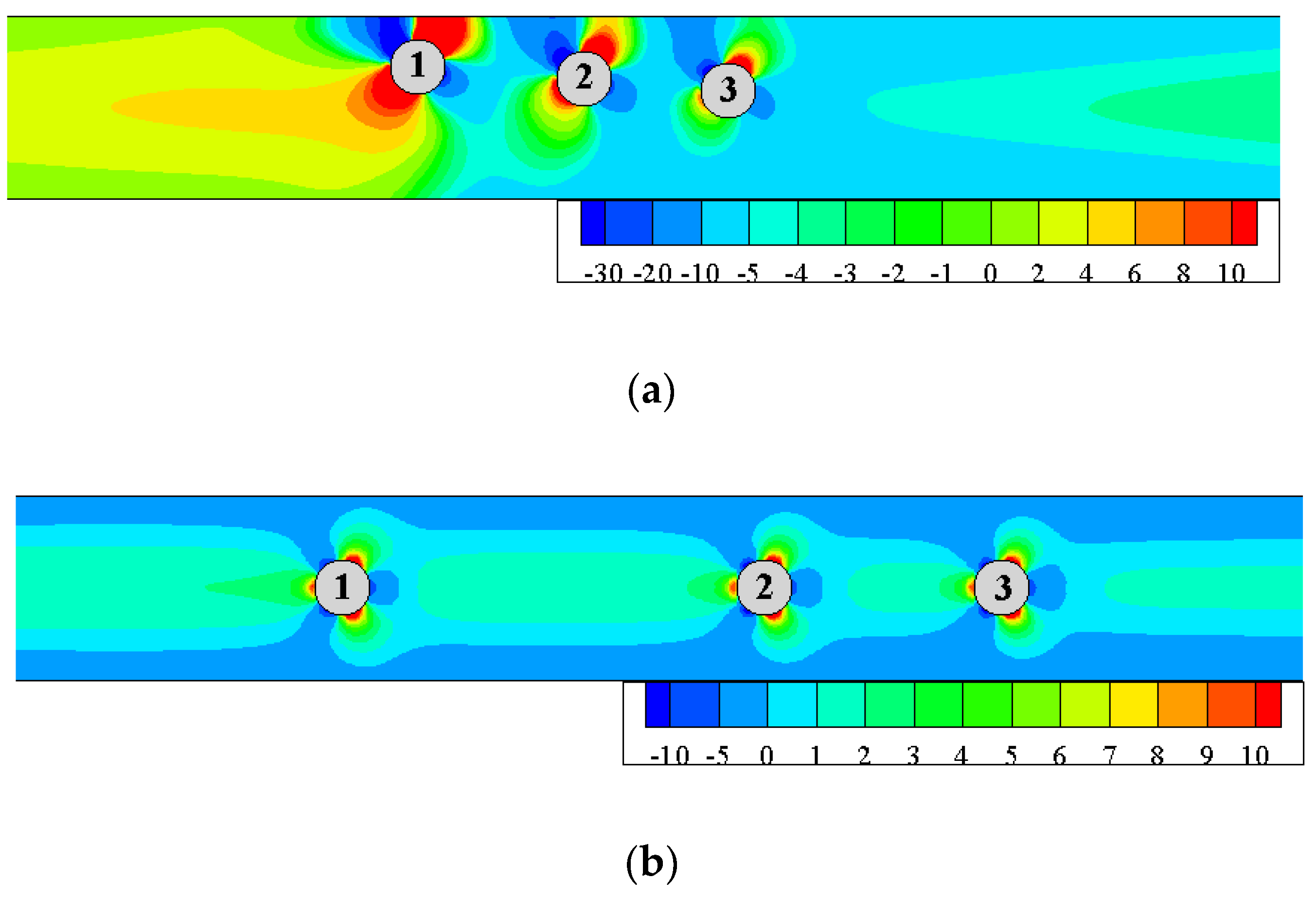
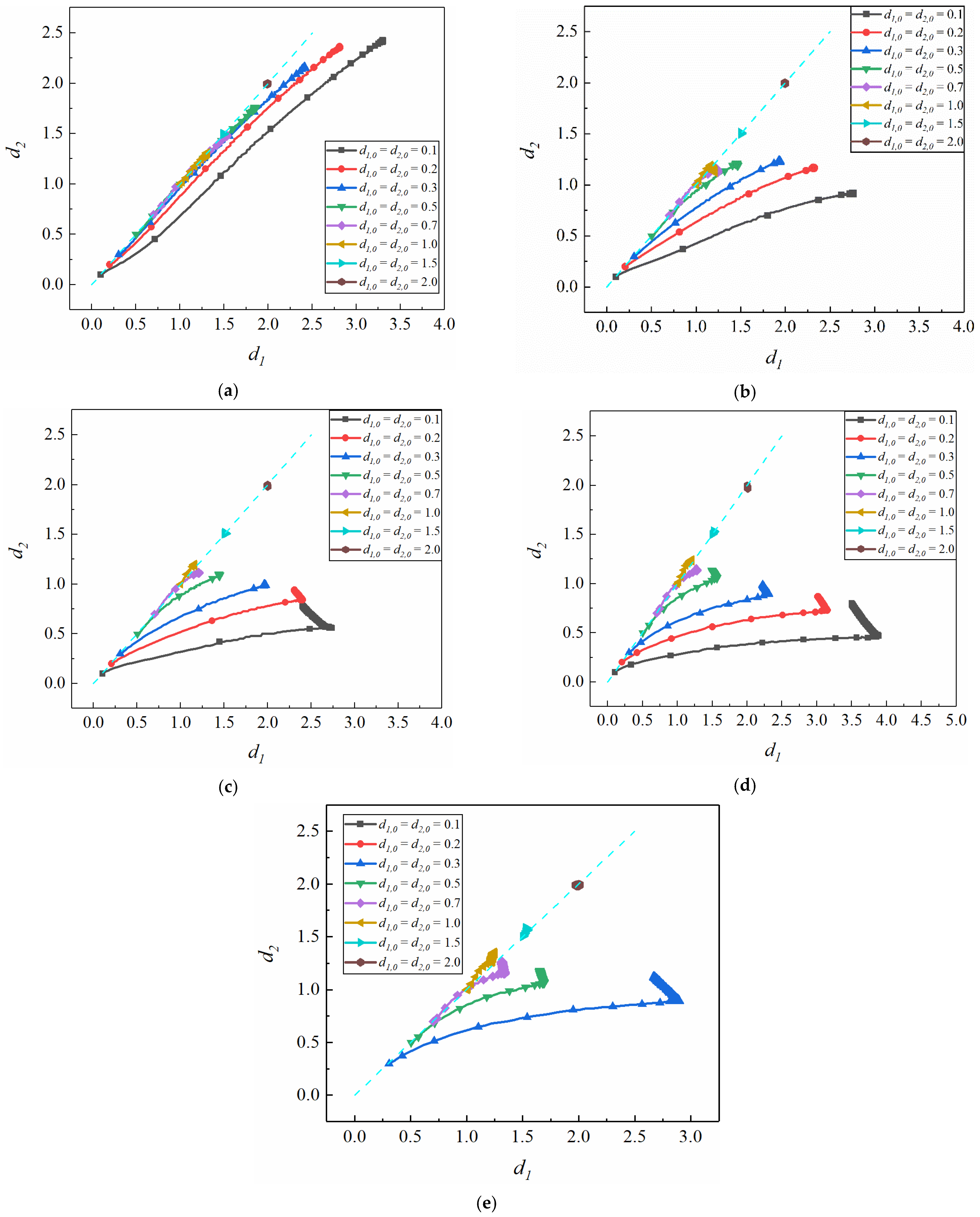


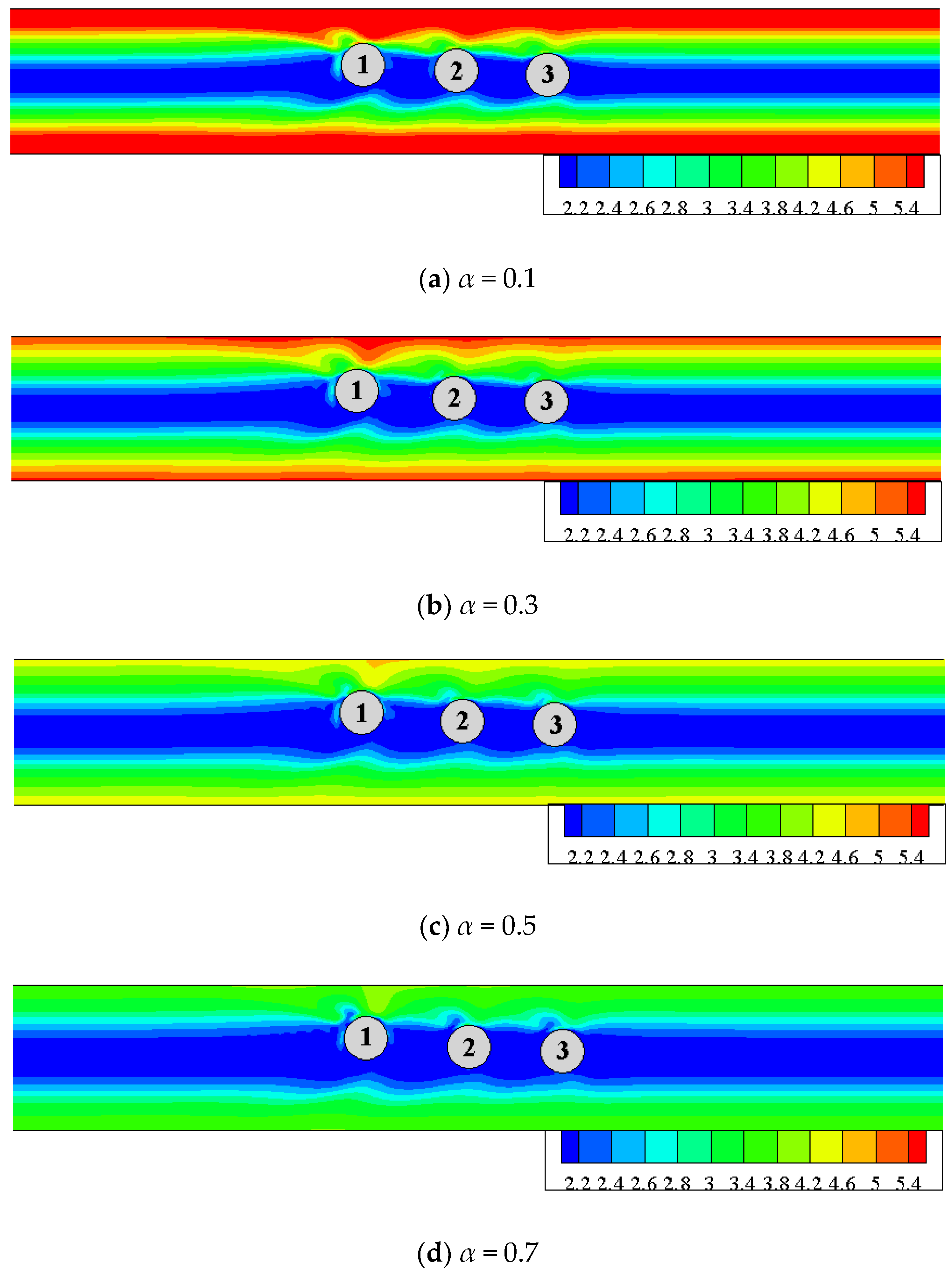
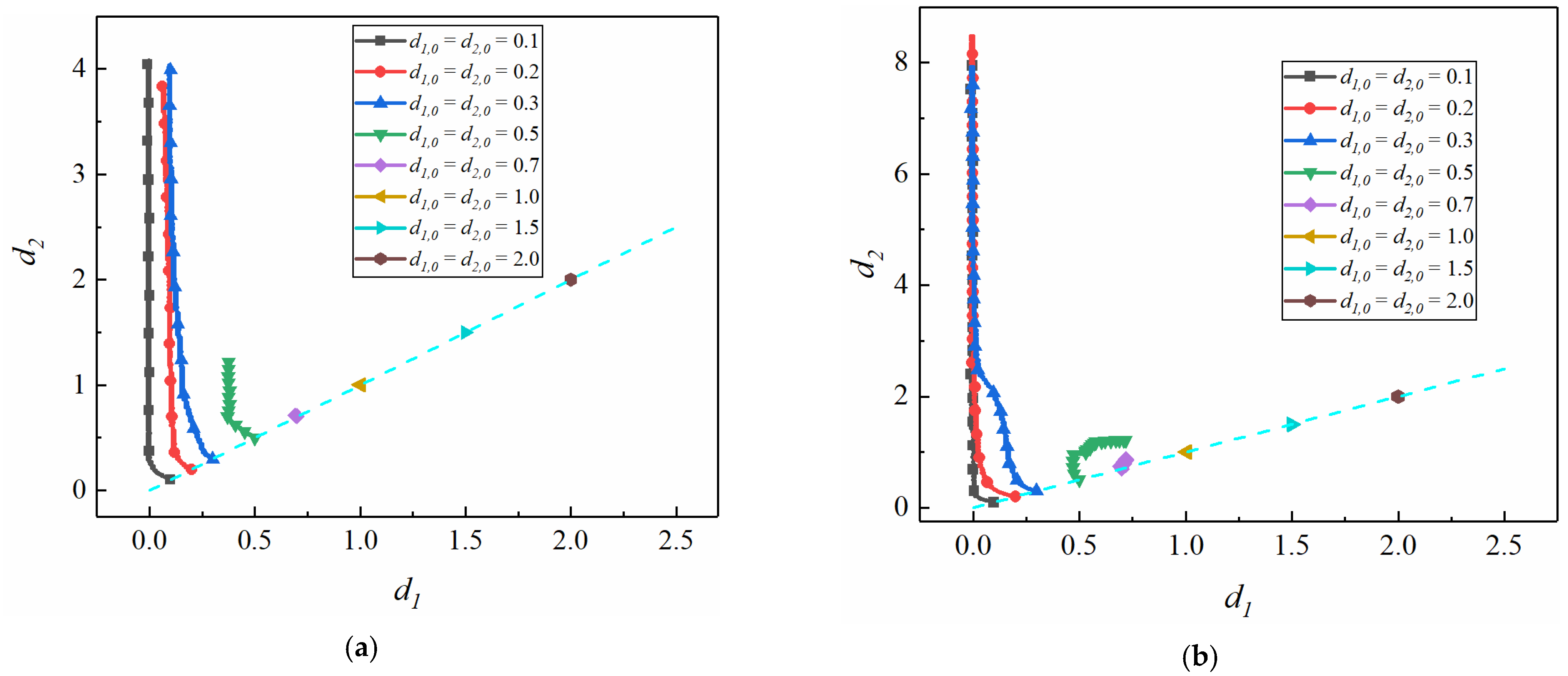

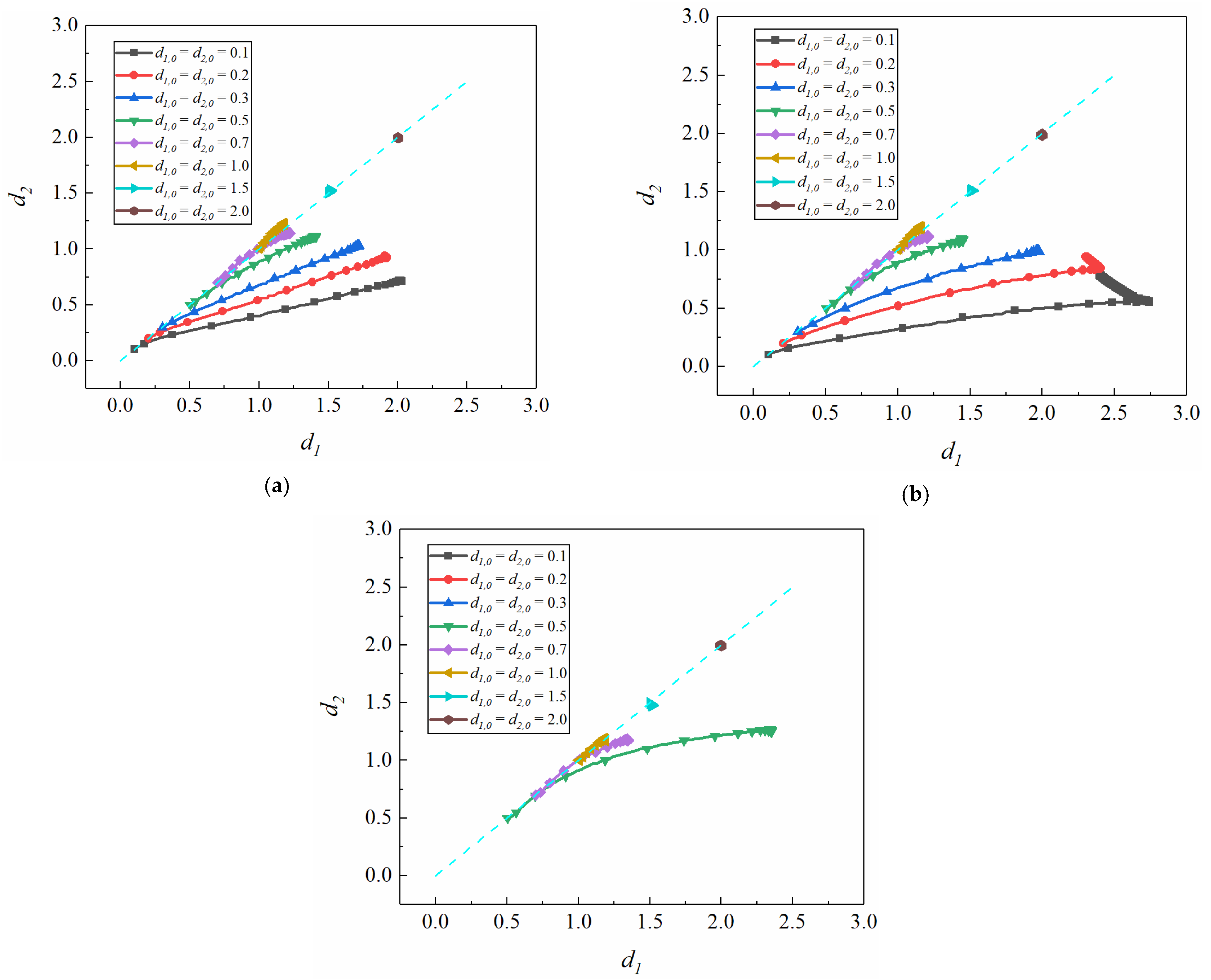


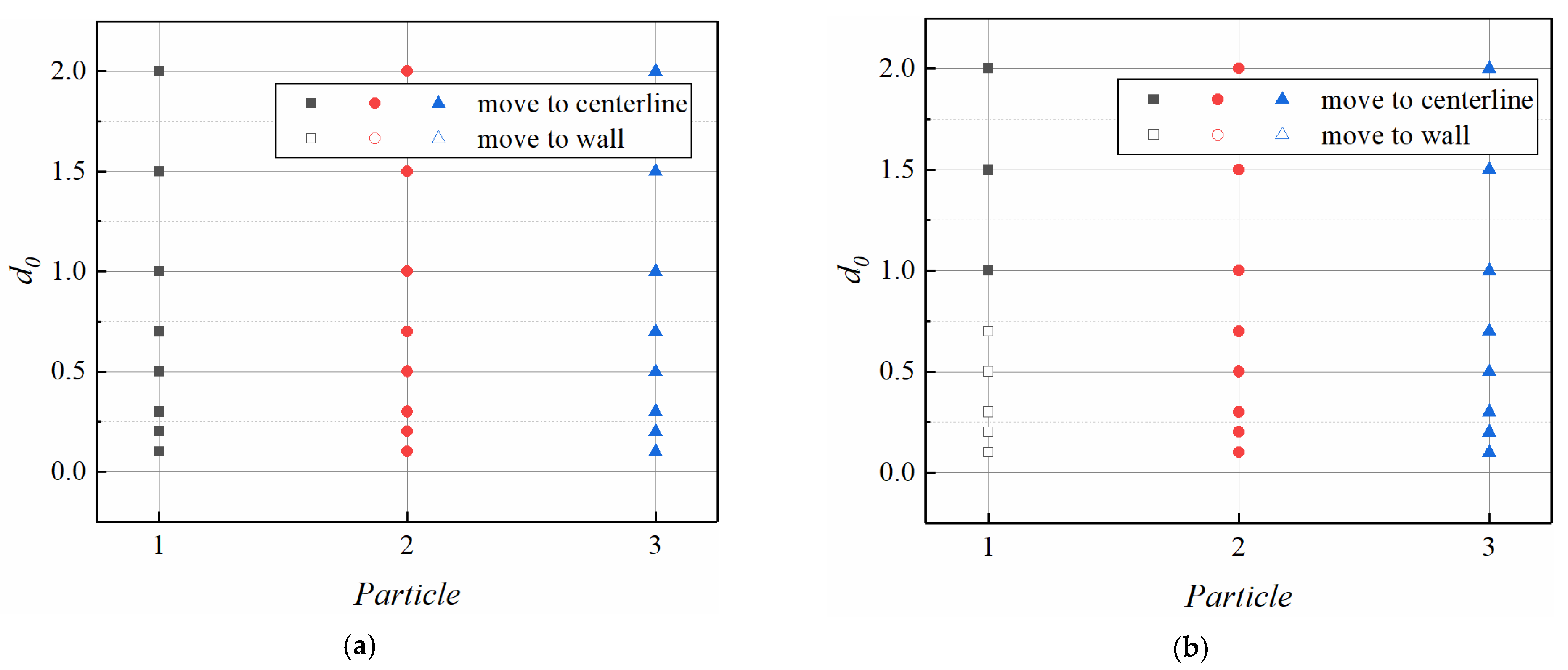
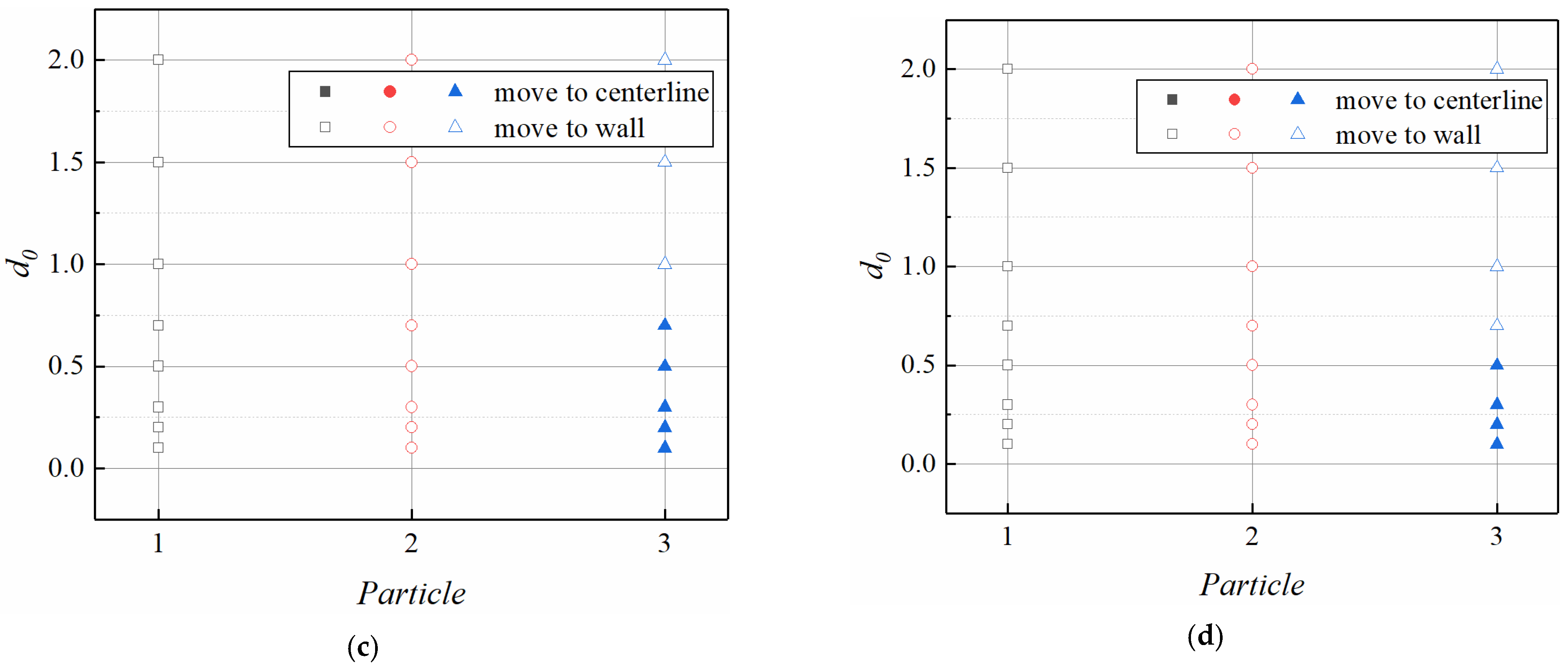

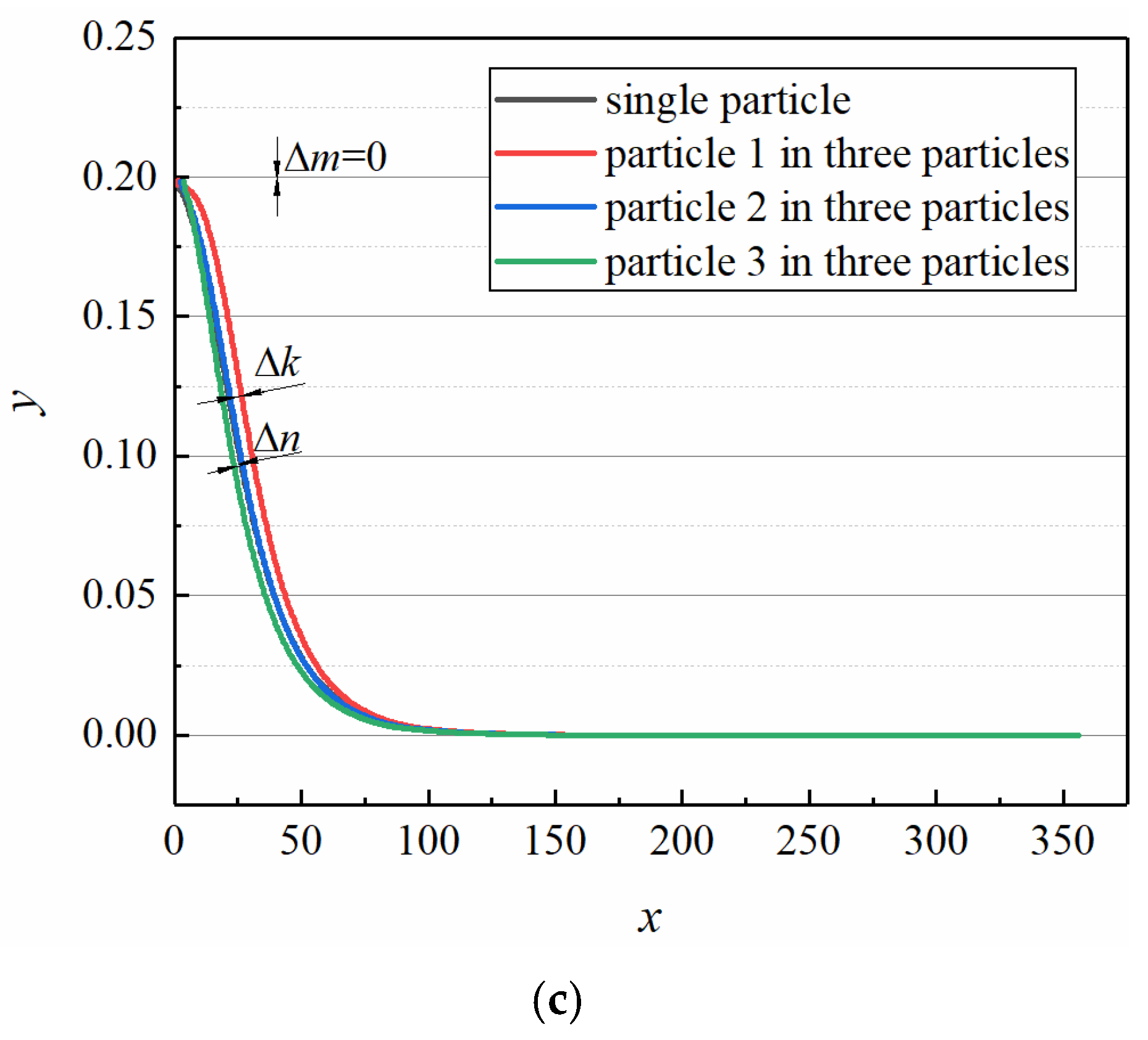
Publisher’s Note: MDPI stays neutral with regard to jurisdictional claims in published maps and institutional affiliations. |
© 2021 by the authors. Licensee MDPI, Basel, Switzerland. This article is an open access article distributed under the terms and conditions of the Creative Commons Attribution (CC BY) license (https://creativecommons.org/licenses/by/4.0/).
Share and Cite
Liu, B.-R.; Lin, J.-Z.; Ku, X.-K. Migration and Alignment of Three Interacting Particles in Poiseuille Flow of Giesekus Fluids. Fluids 2021, 6, 218. https://doi.org/10.3390/fluids6060218
Liu B-R, Lin J-Z, Ku X-K. Migration and Alignment of Three Interacting Particles in Poiseuille Flow of Giesekus Fluids. Fluids. 2021; 6(6):218. https://doi.org/10.3390/fluids6060218
Chicago/Turabian StyleLiu, Bing-Rui, Jian-Zhong Lin, and Xiao-Ke Ku. 2021. "Migration and Alignment of Three Interacting Particles in Poiseuille Flow of Giesekus Fluids" Fluids 6, no. 6: 218. https://doi.org/10.3390/fluids6060218
APA StyleLiu, B.-R., Lin, J.-Z., & Ku, X.-K. (2021). Migration and Alignment of Three Interacting Particles in Poiseuille Flow of Giesekus Fluids. Fluids, 6(6), 218. https://doi.org/10.3390/fluids6060218






